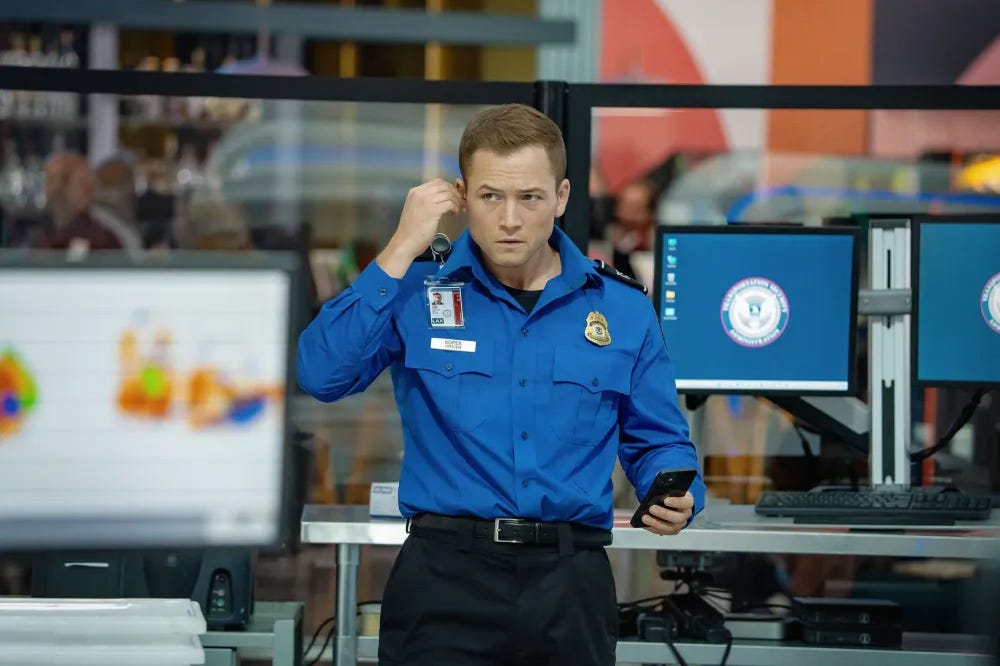'Carry-On' Deserves Better Than the Netflix Abyss
If you're looking for a great old-school thriller, Taron Egerton and Jason Bateman are fighting it out in 'Carry-On' over on Netflix.
Carry-On executes its formula to perfection and, in another life, it would have been a surprise box-office hit of the fall.
But you might also be thinking to yourself, “Carry-On? What the hell is that?”
Recently thrown into the void on Netflix, it’s one of those classic edge-of-your-seat thrillers starring Taron Egerton and an against-type Jason Bateman, both of whom are tremendous leads in this cat-and-mouse game between a TSA agent and a terrorist trying to sneak a weapon on board a flight in between eating snacks at various airport bars.
Movies like Carry-On remind you that a successful thriller doesn’t have to be complicated, though the execution of it is far from easy. Egerton and Bateman have such great chemistry, and the tension builds with each passing scene; perhaps the greatest endorsement is that, like any good thriller, Carry-On’s suspense allows you to freely and easily excuse any and all plot holes, of which I’m sure there are many. But when you’re having this fun, who cares anyway?
Carry-On also makes good use of one of the most important aspects of good filmmaking, and something that has truly become a lost art in recent years: character actors. The supporting cast here is full of guys who’ll make you point at the screen and say, “Hell yeah, he’s in this!” Dean Norris, Theo Rossi, Logan Marshall-Green - a murderer’s row of supporting talent this strong instantly becomes the backbone against which our leads can shine even brighter.
And boy do they. Egerton clearly has the movie-star charisma oozing out of him, and Bateman plays a menacing terrorist - or terrorist facilitator, or whatever the hell’s he doing; the appeal here is the movie doesn’t spend too much time trying to explain who “The Traveler” is. It doesn’t need to do that to get our buy-in anyway.
All of this is to say that Carry-On is old school in the best way, which in some sense simply means Carry-On is super competent, relying on its leads every step of the way. You could certainly try to explain those aforementioned plot holes to me, but I won’t care; it’ll no effect on my enjoyment of the movie. If anything, I’ll probably like it more for the endearing quality of eschewing “realism” for good old-fashioned movie magic.
Now, in true Netflix fashion, Carry-On had about a three-second window to go truly viral on the platform and beyond, to start trending on social media. But that window has apparently passed, and it’ll be buried under a mountain of slop soon enough. The movie will disappear into the Netflix abyss as all Netflix films are destined to do, never to be seen again, and with no physical release to be had (by legal means, anyway).
And I say that even with the news that Carry-On has become one of the most-streamed Netflix movies of all time, entering the platform’s all-time top ten list. What exactly does that mean, though? The film garnered nearly 100 million views in its first ten days of being released, but what does that actually look like, and is anyone really talking about it? We all know Netflix cooks those numbers to the point they mean absolutely nothing in any real context of how audiences interact with and perceive a film.
Even as it sits within Netflix’s top ten, the onslaught of new material in the overall streaming environment makes it difficult for a streaming-only release to enter the zeitgeist - it’s just not how streaming is designed to work; it will always be an isolated world. No matter how popular Netflix wants us to believe one of its films is, it will unfortunately never reach the general moviegoing public the way a theatrical release would have.
In another life, Carry-On would have gotten a 3-4 week window to enjoy a box-office run with little competition ahead of the big Christmas releases. It might even maintain its momentum as an alternative choice among the family-friendly juggernauts like Sonic 3 and Mufasa or the horror counter-programming of Nosferatu.
Maybe someday we’ll get back to a better world like that.




